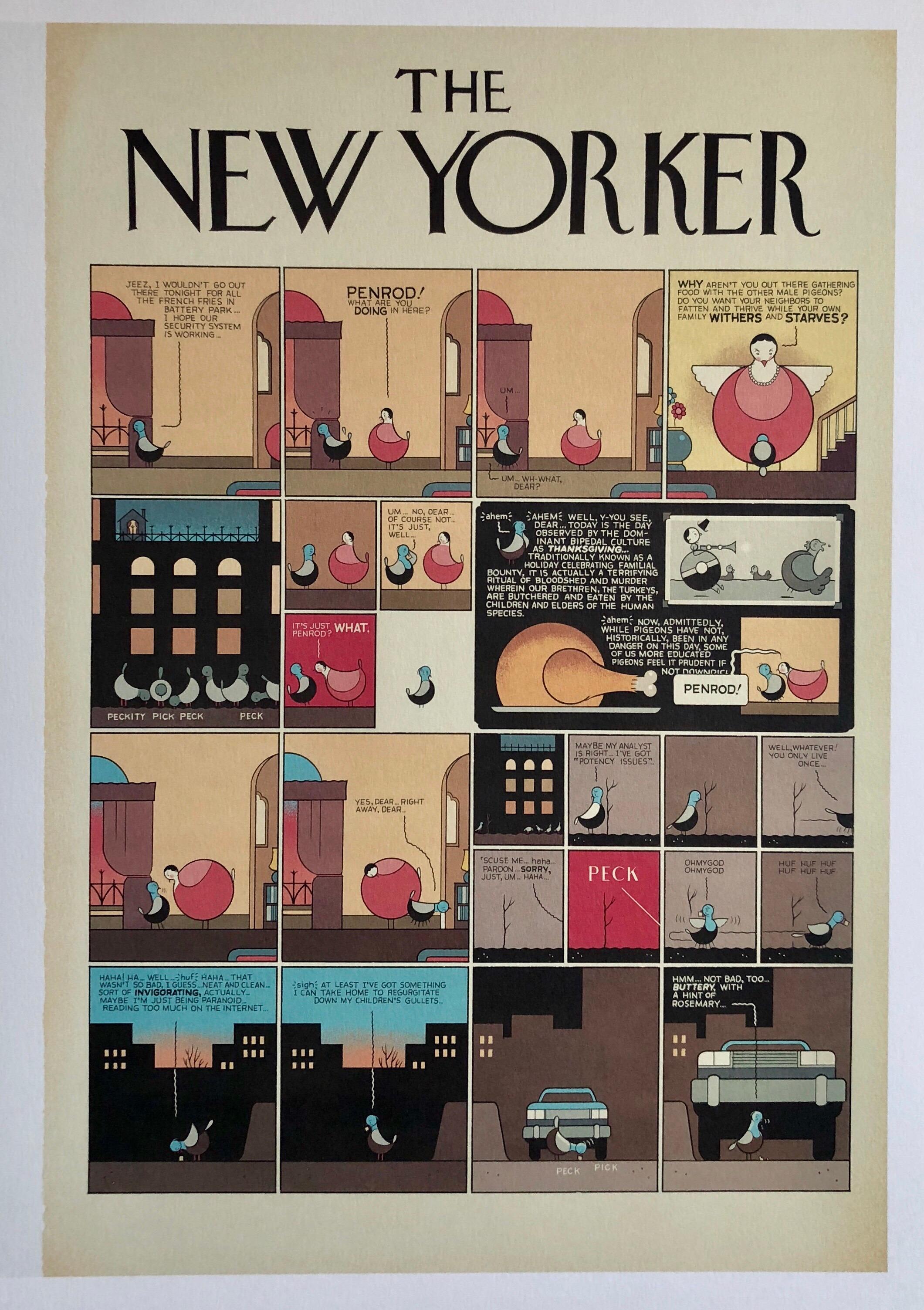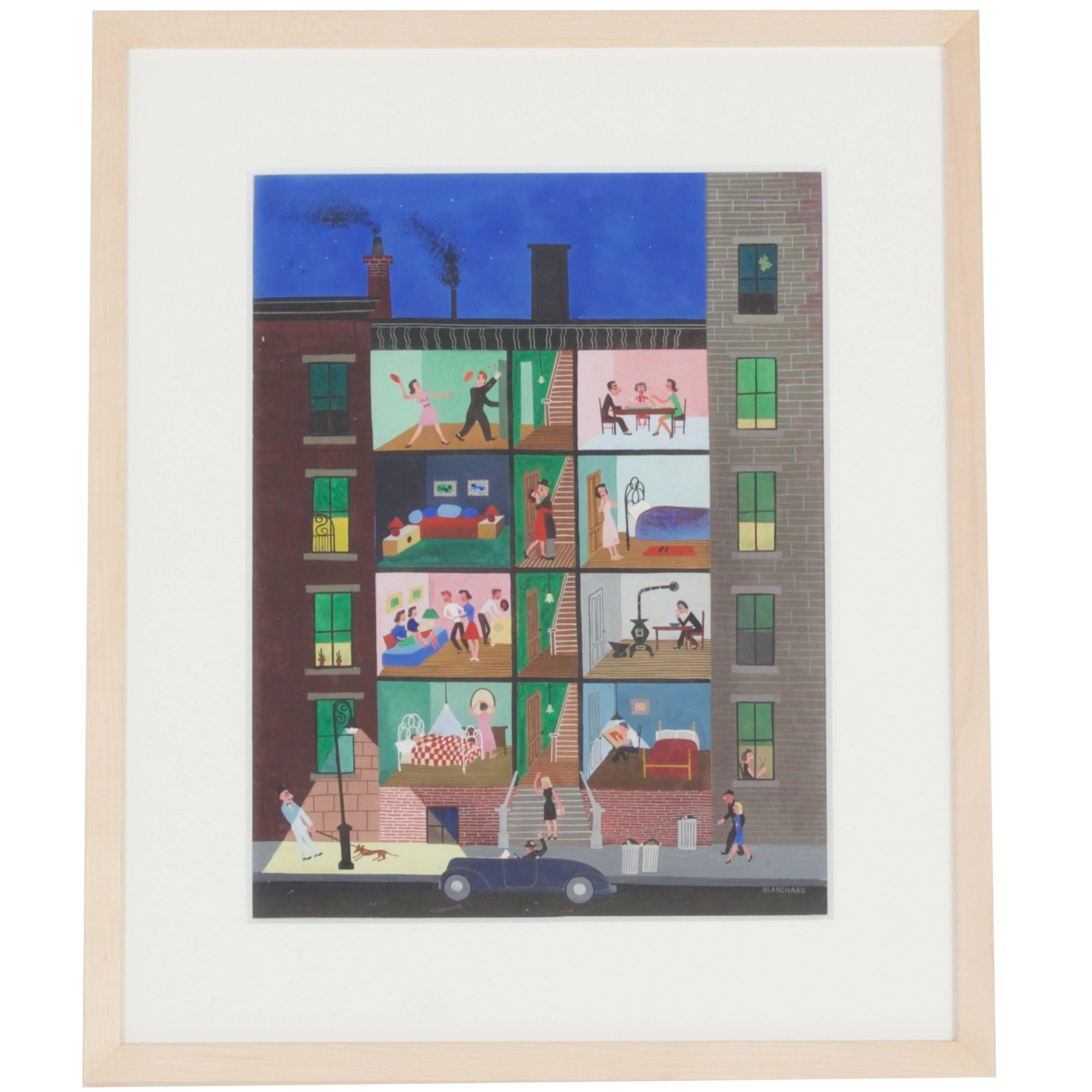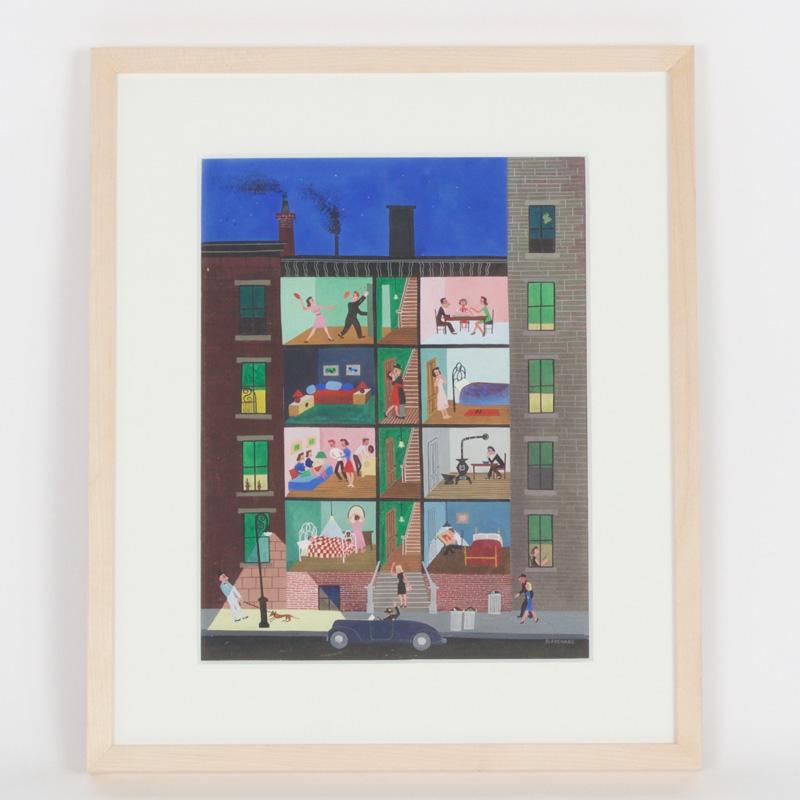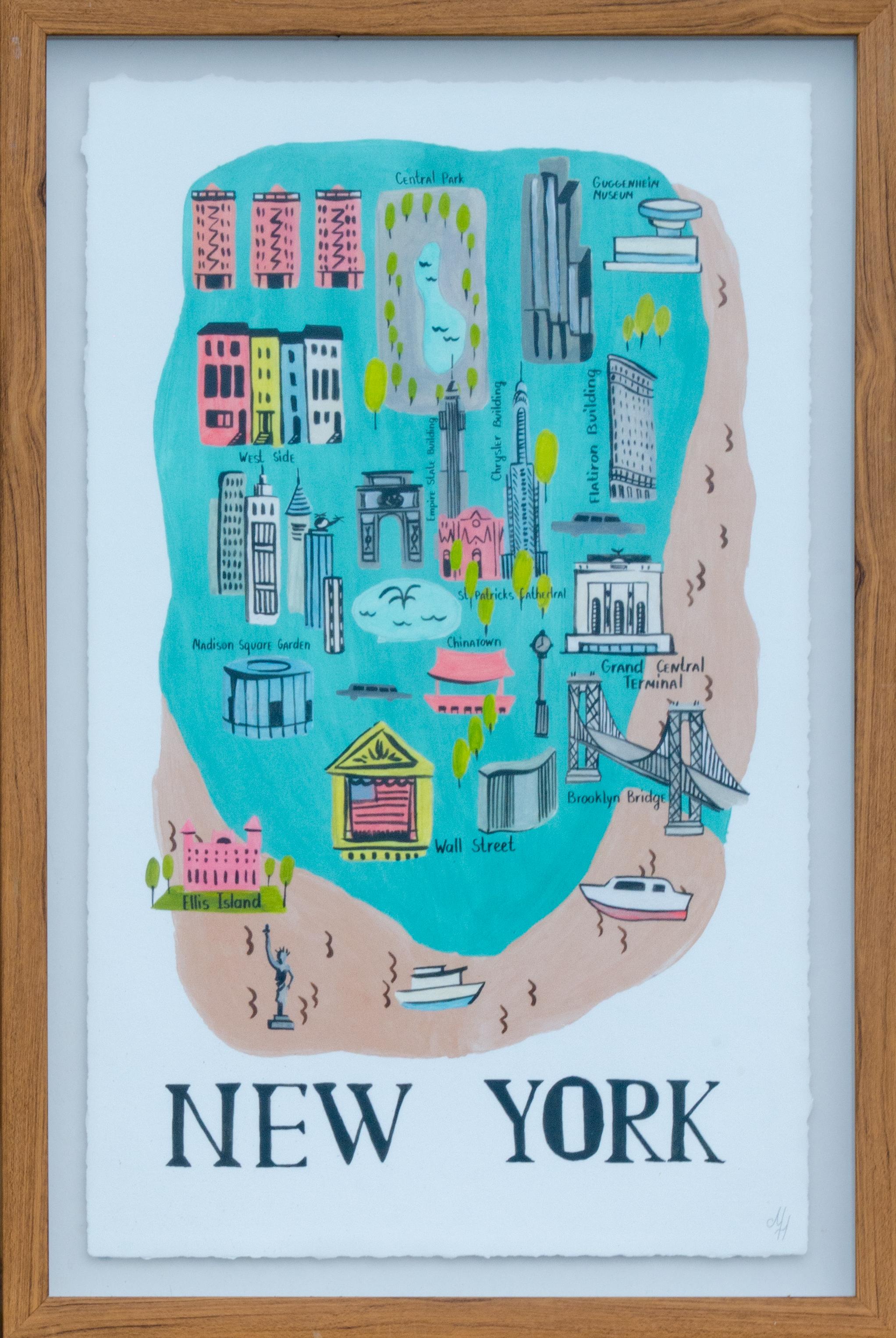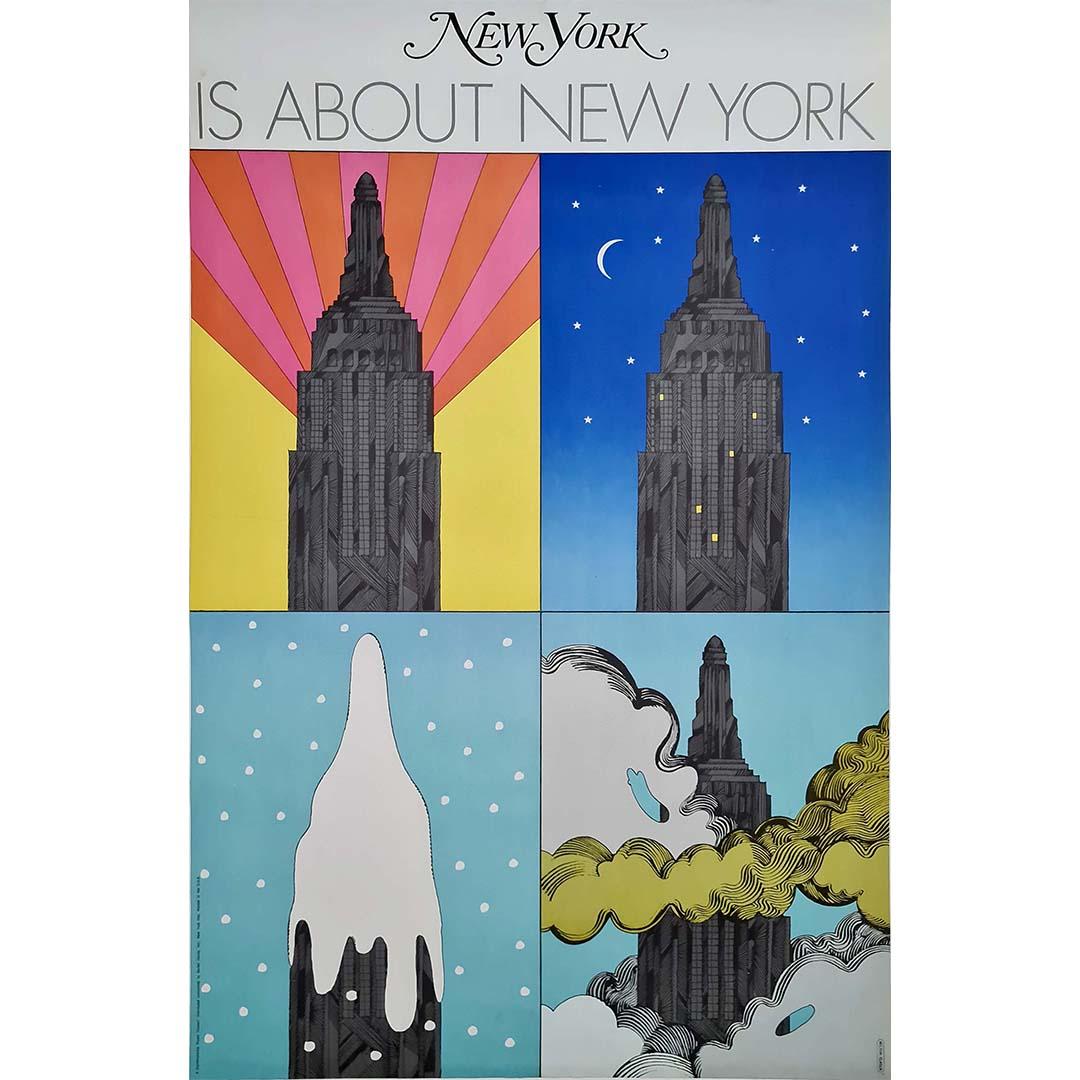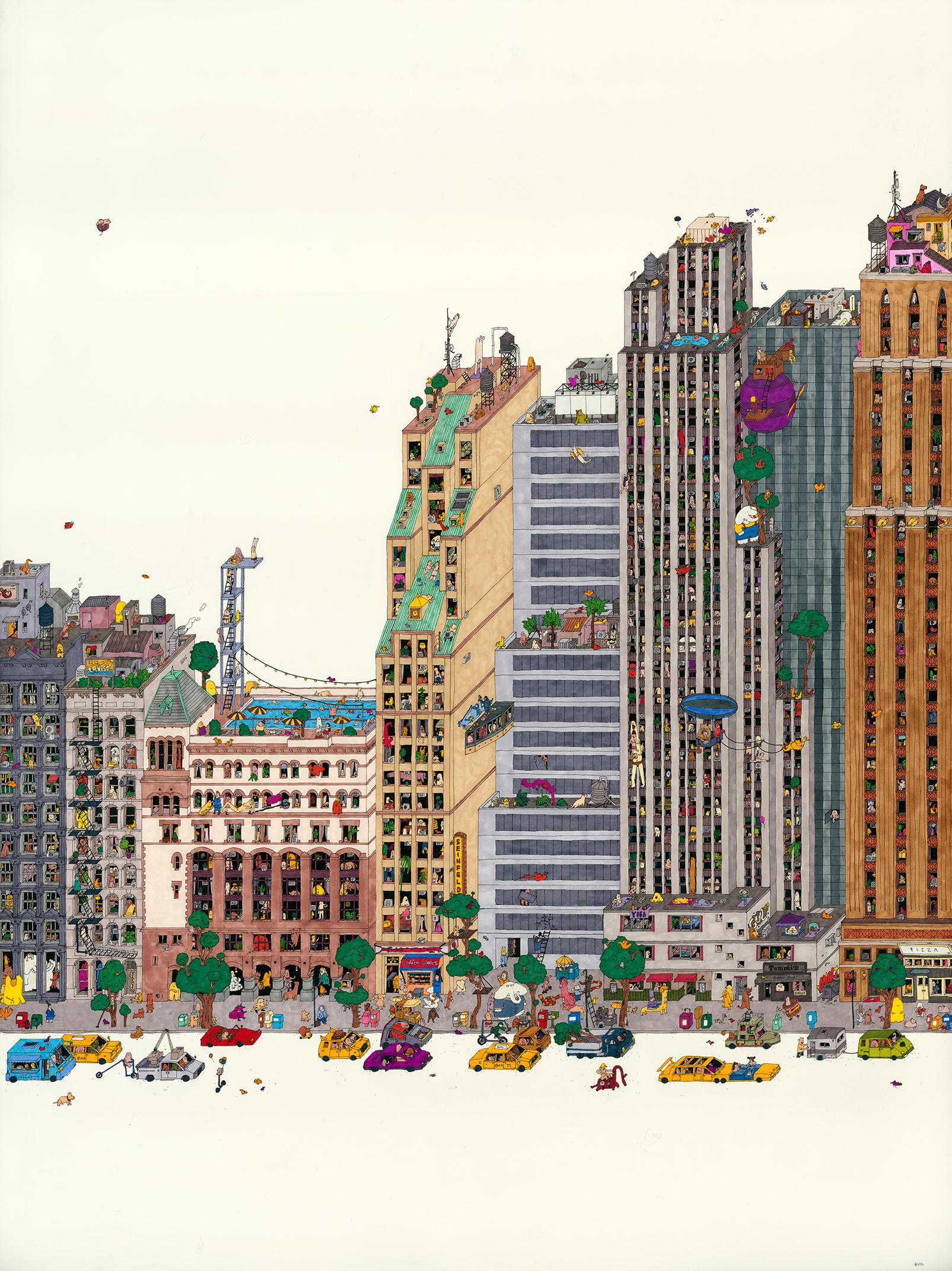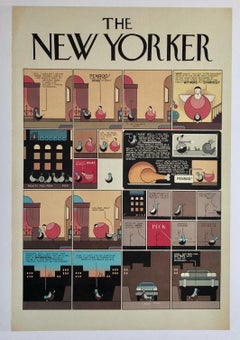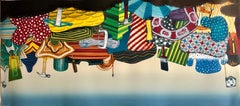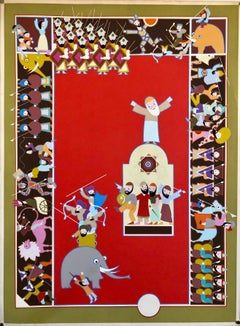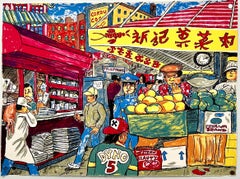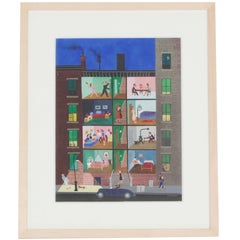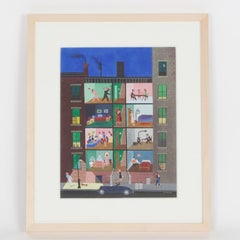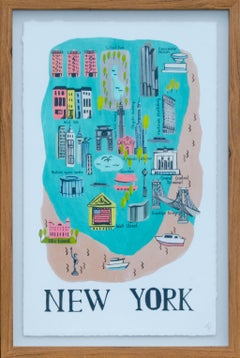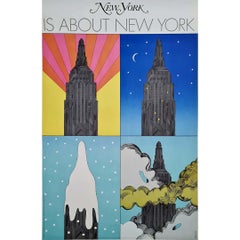Items Similar to Chris Ware New Yorker Cartoonist Limited Edition Thanksgiving Print NYC
Want more images or videos?
Request additional images or videos from the seller
1 of 12
Chris WareChris Ware New Yorker Cartoonist Limited Edition Thanksgiving Print NYC2006
2006
$250
£192.95
€219.66
CA$356.98
A$389.35
CHF 205.16
MX$4,669.40
NOK 2,583.18
SEK 2,410.06
DKK 1,640.45
About the Item
This is one print – printed in full color on 15" x 20" heavy cream-colored paper.
It is from a limited edition series of 175,
the portfolio is hand numbered and hand signed by Chris Ware. the individual prints are not.
The page with the hand signature is included here as a photo for reference only it is not included in this sale.
Franklin Christenson "Chris" Ware (born December 28, 1967), is an American cartoonist known for his Acme Novelty Library series (begun 1994) and the graphic novel Jimmy Corrigan, the Smartest Kid on Earth (2000) and Building Stories (2012). His works explore themes of social isolation, emotional torment and depression. He tends to use a vivid color palette and realistic, meticulous detail. His lettering and images are often elaborate and sometimes evoke the ragtime era or another early 20th-century American design style.
Ware often refers to himself in the publicity for his work in self-effacing, even withering tones. He is considered by some critics and fellow notable illustrators and writers, such as Dave Eggers, to be among the best currently working in the medium; Canadian graphic-novelist Seth has said, "Chris really changed the playing field. After him, a lot of [cartoonists] really started to scramble and go, 'Holy [expletive], I think I have to try harder.'"
While still a sophomore at UT, Ware came to the attention of Art Spiegelman, who invited Ware to contribute to Raw, the influential anthology magazine Spiegelman was co-editing with Françoise Mouly. Ware has acknowledged that being included in Raw gave him confidence and inspired him to explore printing techniques and self-publishing. His Fantagraphics series Acme Novelty Library defied comics publishing conventions with every issue.
Ware's art reflects early 20th-century American styles of cartooning and graphic design, shifting through formats from traditional comic panels to faux advertisements and cut-out toys. Stylistic influences include advertising graphics from that same era; newspaper strip cartoonists Winsor McCay (Little Nemo in Slumberland) and Frank King (Gasoline Alley); Charles Schulz's post-WWII strip Peanuts and the cover designs of ragtime-era sheet music. Ware has spoken about finding inspiration in the work of artist Joseph Cornell and cites Richard McGuire's strip Here as a major influence on his use of non-linear narratives. He is one of the great practitioners who have elevated the graphic novel style along with, Shepard Fairey, Ben Katchor and Robert Crumb.
Quimby the Mouse was an early character for Ware and something of a breakthrough. Rendered in the style of an early animation character like Felix the Cat, Quimby the Mouse is perhaps Ware's most autobiographical character.
Ware's Building Stories was serialized in a host of different venues. It first appeared as a monthly strip in Nest Magazine. Installments later appeared in a number of publications, including The New Yorker, Kramer's Ergot, and most notably, the Sunday New York Times Magazine. Building Stories appeared weekly in the New York Times Magazine from September 18, 2005 until April 16, 2006. A full chapter was published in Acme Novelty Library, number 18. Another installment was published under the title "Touch Sensitive" as a digital app released through McSweeneys. The entire narrative was published as a boxed set of books by Pantheon in October 2012.
Ware was commissioned by Chip Kidd to design the inner machinations of the bird on the cover of Haruki Murakami's novel The Wind-Up Bird Chronicle.
In 2011, Ware created the poster for the U.S. release of the 2010 Palme d'Or winning film Uncle Boonmee Who Can Recall His Past Lives by Thai director Apichatpong Weerasethakul.
Awards and honors
Over the years his work garnered several awards, including the 1999 National Cartoonists Society's Award for Best Comic Book for Acme Novelty Library and Award for Graphic Novel for Building Stories.
Ware has won numerous Eisner Awards and multiple Harvey Awards. In 2002, Ware became the first comics artist to be invited to exhibit at Whitney Museum of American Art biennial exhibition. With Will Eisner, Jack Kirby, Harvey Kurtzman, Robert Crumb and Gary Panter, Ware was among the artists honored in the exhibition "Masters of American Comics" at the Jewish Museum in New York City, New York, from September 16, 2006 to January 28, 2007. His work was the subject of solo exhibitions at the Museum of Contemporary Art, Chicago in 2006 and at the University of Nebraska's Sheldon Museum of Art, in 2007.
Many famous artists have done covers for the New Yorker Magazine including, Saul Steinberg, Maira Kalman, Art Spiegelman, Francoise Mouly, Charles Addams, Peter Arno, Roz Chast, Ed Koren, William Steig, James Thurber and many others. This one is a fresh contemporary take on the Norman Rockwell classic.
Ware's graphic novel Jimmy Corrigan, the Smartest Kid on Earth won the 2001 Guardian First Book Award, the first time a graphic novel has won a major United Kingdom book award. It also won the prize for best album at the 2003 Angoulême International Comics Festival in France.
In 2006, Ware received a USA Hoi Fellow grant from United States Artists.
In 2013, Ware received the 2013 Lynd Ward Graphic Novel Prize for Building Stories and was finalist for Jan Michalski Prize for Literature and Los Angeles Times Book Prize.
- Creator:Chris Ware (1967)
- Creation Year:2006
- Dimensions:Height: 20 in (50.8 cm)Width: 15 in (38.1 cm)
- Movement & Style:
- Period:
- Condition:
- Gallery Location:Surfside, FL
- Reference Number:1stDibs: LU38213654502
About the Seller
4.9
Platinum Seller
Premium sellers with a 4.7+ rating and 24-hour response times
Established in 1995
1stDibs seller since 2014
1,842 sales on 1stDibs
Typical response time: 1 hour
- ShippingRetrieving quote...Shipping from: Surfside, FL
- Return Policy
More From This Seller
View AllChris Ware New Yorker Cartoonist Limited Edition Thanksgiving Print NYC
By Chris Ware
Located in Surfside, FL
This is one print – printed in full color on 15" x 20" heavy cream-colored paper.
It is from a limited edition series of 175,
the portfolio is hand numbered and hand signed by Chris Ware. the individual prints are not.
The page with the hand signature is included here as a photo for reference only it is not included in this sale.
Franklin Christenson "Chris" Ware (born December 28, 1967), is an American cartoonist known for his Acme Novelty Library series (begun 1994) and the graphic novel Jimmy Corrigan, the Smartest Kid on Earth (2000) and Building Stories (2012). His works explore themes of social isolation, emotional torment and depression. He tends to use a vivid color palette and realistic, meticulous detail. His lettering and images are often elaborate and sometimes evoke the ragtime era or another early 20th-century American design style.
Ware often refers to himself in the publicity for his work in self-effacing, even withering tones. He is considered by some critics and fellow notable illustrators and writers, such as Dave Eggers, to be among the best currently working in the medium; Canadian graphic-novelist Seth has said, "Chris really changed the playing field. After him, a lot of [cartoonists] really started to scramble and go, 'Holy [expletive], I think I have to try harder.'"
While still a sophomore at UT, Ware came to the attention of Art Spiegelman, who invited Ware to contribute to Raw, the influential anthology magazine Spiegelman was co-editing with Françoise Mouly. Ware has acknowledged that being included in Raw gave him confidence and inspired him to explore printing techniques and self-publishing. His Fantagraphics series Acme Novelty Library defied comics publishing conventions with every issue.
Ware's art reflects early 20th-century American styles of cartooning and graphic design, shifting through formats from traditional comic panels to faux advertisements and cut-out toys. Stylistic influences include advertising graphics from that same era; newspaper strip cartoonists Winsor McCay (Little Nemo in Slumberland) and Frank King (Gasoline Alley); Charles Schulz's post-WWII strip Peanuts and the cover designs of ragtime-era sheet music. Ware has spoken about finding inspiration in the work of artist Joseph Cornell and cites Richard McGuire's strip Here as a major influence on his use of non-linear narratives. He is one of the great practitioners who have elevated the graphic novel style along with, Shepard Fairey, Ben Katchor and Robert Crumb.
Quimby the Mouse was an early character for Ware and something of a breakthrough. Rendered in the style of an early animation character like Felix the Cat, Quimby the Mouse is perhaps Ware's most autobiographical character.
Ware's Building Stories was serialized in a host of different venues. It first appeared as a monthly strip in Nest Magazine. Installments later appeared in a number of publications, including The New Yorker, Kramer's Ergot, and most notably, the Sunday New York Times Magazine. Building Stories appeared weekly in the New York Times Magazine from September 18, 2005 until April 16, 2006. A full chapter was published in Acme Novelty Library, number 18. Another installment was published under the title "Touch Sensitive" as a digital app released through McSweeneys. The entire narrative was published as a boxed set of books by Pantheon in October 2012.
Ware was commissioned by Chip Kidd to design the inner machinations of the bird on the cover of Haruki Murakami's novel The Wind-Up Bird Chronicle.
In 2011, Ware created the poster for the U.S. release of the 2010 Palme d'Or winning film Uncle Boonmee Who Can Recall His Past Lives by Thai director Apichatpong Weerasethakul.
Awards and honors
Over the years his work garnered several awards, including the 1999 National Cartoonists Society's Award for Best Comic Book for Acme Novelty Library and Award for Graphic Novel for Building Stories.
Ware has won numerous Eisner Awards and multiple Harvey Awards. In 2002, Ware became the first comics artist to be invited to exhibit at Whitney Museum of American Art biennial exhibition. With Will Eisner, Jack Kirby, Harvey Kurtzman, Robert Crumb and Gary Panter, Ware was among the artists honored in the exhibition "Masters of American Comics" at the Jewish Museum in New York City, New York, from September 16, 2006 to January 28, 2007. His work was the subject of solo exhibitions at the Museum of Contemporary Art, Chicago in 2006 and at the University of Nebraska's Sheldon Museum of Art, in 2007.
Many famous artists have done covers for the New Yorker Magazine including, Saul Steinberg, Maira Kalman, Art Spiegelman, Francoise Mouly, Charles Addams, Peter Arno, Roz Chast, Ed Koren...
Category
Early 2000s American Modern Figurative Prints
Materials
Color
Color Lithograph Linocut Chine Collé "Workshop" Bright Modernist Pop Art
By Tom Burckhardt
Located in Surfside, FL
Hand signed and numbered edition of 25. 16 x 36" sheet size without frame.
“Workshop” is an ambitious color lithograph and linocut with chine collé printed in twelve colors from nine plates and one linocut. It has been printed in an edition of 25, plus proofs, on white Rives BFK paper 16 x 36” with chine collé of various papers. (No, it’s not upside down)
Born 1964 in New York where he still currently resides and works alongside his partner the ceramist Kathy Butterly. Son of the photographer Rudy Burckhardt and painter Yvonne Jacquette, Tom Burckhardt was 1986, BFA, State University of New York, Purchase, NY
1992–1993, Skowhegan School of Painting and Sculpture, ME
1996, Marie Walsh Sharpe Art Foundation Studio Grant
1997, New York Foundation for the Arts, Painting Grant
1997 Pollock-Krasner Foundation Grant
2002 George Hitchcock Award, National Academy of Arts
2003, Richard & Hinda Rosenthal Foundation Award, American Academy
2005, AICA Best Show of an Emerging or Underknown Artist
2005 Pollock-Krasner Foundation Grant
2006 Best Installation, Best of Houston, the Houston Press
2009 Guggenheim Foundation Grant
2010, New York Foundation for the Arts Drawing/Print Grant
2010 Joan Mitchell Foundation Grant
Tom Burckhardt’s work is a carnival of images jumbled and jostling each other in precarious nonsensical compositions. He uses lushly colored and patterned images from all kinds of sources that bounce between abstraction and representation. Images come from tool catalogs, paper and fabric patterns, funhouse painting, architectural details, stripes, dots and squiggles. It is as if Burckhardt is a cartoonist merrily channeling Ellsworth Kelly, Paul Feeley, Robert Therrien, and Myron Stout, among others. Like Red Grooms, for whom he worked as an assistant, Burckhardt ransacks his influences yet ends up with something unmistakably his own. His work bears the influence of is a synthesis of many things: the tribal-influenced abstract painting of Steve Wheeler...
Category
Early 2000s Pop Art Interior Prints
Materials
Lithograph, Linocut
Israeli Modern Hanukkah Lithograph Silkscreen David Sharir Holiday Serigraph Art
By David Sharir
Located in Surfside, FL
This is a mixed lithograph and serigraph silkscreen as per descriptions i read. this is not signed or numbered and is marked sample. it is a rare artists or printers proof print.
David Sharir was born in 1938 in Tel Aviv, Israel and currently resides there.
David Sharir, the son of Russian immigrants, was born in Israel. Beginning his study of art in Tel Aviv and continuing in Florence and Rome, where he studied architecture and theater design. The brightly colored costumes and intricate stage designs he created for these productions have profoundly influenced his art. When Sharir moved to Jaffa in 1966, his hallmark style was truly developed. Studio, family, and spiritual devotion all serve as inspiration for the imagery in his work. His evolving style combines personal experience, Biblical symbolism, and fantasy.
David Sharir, born 1938, Tel Aviv. Was among the first artists to settle in Old Jaffa in 1966. He depicted biblical subjects with a touch of humour and designed sets and costumes for the theatre and opera.
Graphic Art in Israel Today Tel Aviv Museum, Tel Aviv 1973
Israel 1948-1958: Watercolors, Drawings, Graphics
The Bezalel National Museum, Jerusalem 1958
Jean David, Yosl Bergner, Menachem Shemi, Zvi Mairovich, Ruth Schloss, Nahum Gutman, Moshe Elazar Castel...
Category
20th Century Contemporary Figurative Prints
Materials
Lithograph
Red Grooms Canal St Chinatown Manhattan New York City Lithograph Cartoon Pop Art
By Red Grooms
Located in Surfside, FL
Red Grooms (American, b. 1937).
Lithograph in colors on wove paper, 1993
"East of Canal Street, Corner of Canal."
Published by the Brooklyn Museum
(Reference: Red Grooms: The Graphic Work, Walter G. Knestrick. Harry Abrams Inc Publishers, New York, 2001. Cat. no 138 page 172,
Alexander & Cowles 138).
Downtown Manhattan, New York City Chinatown Street scene with various vendors.
Hand signed in black crayon and numbered on image at bottom edge.
"8/115 Red Grooms."
Dimensions 22" x 30"
Printer: Sharks Lithographs Ltd, Boulder, CO
Red Grooms (born Charles Rogers Grooms on June 7, 1937) is an American multimedia artist best known for his colorful pop-art constructions depicting frenetic scenes of modern urban life. Grooms was given the nickname "Red" by Dominic Falcone (of Provincetown's Sun Gallery) when he was starting out as a dishwasher at a restaurant in Provincetown and was studying with Hans Hofmann.
Grooms was born in Nashville, Tennessee during the middle of the Great Depression. Red Grooms came of age in the shadow of the Abstract Expressionists. He studied at the Art Institute of Chicago, then at Nashville's Peabody College. In 1956, Grooms moved to New York City, to enroll at the New School for Social Research. A year later, Grooms attended a summer session at the Hans Hofmann School of Fine Arts in Provincetown, Massachusetts. There he met experimental animation pioneer Yvonne Andersen, with whom he collaborated on several short films. Grooms follows in the tradition of William Hogarth and Honoré Daumier, who were canny commentators on the human condition. In 1969, Peter Schjeldahl compared Grooms to Marcel Duchamp, because both embodied "a movement of one man that is open to everybody."
In the spring of 1958, Grooms, Yvonne Andersen and Lester Johnson each painted twelve-foot by twelve-foot panels, which they erected with telephone poles on a parking lot adjacent an amusement park in Salisbury, MA. Inspired by artist-run spaces such as New York's Hansa Gallery and Phoenix, and Provincetown's Sun Gallery, Grooms and painter Jay Milder opened the City Gallery in Grooms' second-floor loft in the Flatiron District. When Phoenix refused to show Claes Oldenburg, Grooms and Milder dropped out of Phoenix and City Gallery presented Oldenberg's first New York exhibition, as well as that of Jim Dine. Other artists who showed at City Gallery include Stephen Durkee, Mimi Gross (daughter of Chaim Gross and Red Grooms wife), Bob Thompson, Lester Johnson, and Alex Katz. Grooms never developed the detached stance of such Pop Art practitioners as Andy Warhol, Roy Lichtenstein or James Rosenquist. Instead he painted his own life, and became, literally, an actor on the stage of life -- in this case the art-as-life "happenings" of the downtown New York scene. Inspired by George Méliès's 1902 film A Trip to the Moon...
Category
1990s Pop Art Figurative Paintings
Materials
Lithograph
Lithograph Print Pattern & Decoration Art Honor Father & Mother Robert Kushner
By Robert Kushner
Located in Surfside, FL
Robert Ellis Kushner (American, b.1949).
44/84 Lithograph on paper titled " Honor thy Mother and Father"; Depicting a husband and wife (I have seen this print described as a screenprint and as a lithograph)
Hand signed in pencil and dated alongside an embossed pictorial blindstamp of a closed hand with one raised index finger. Solo Press.
From The Ten Commandments Kenny Scharf; Joseph Nechvatal; Gretchen Bender; April Gornik; Robert Kushner; Nancy Spero; Vito Acconci; Jane Dickson; Judy Rifka; Richard Bosman and Lisa Liebmann.
Robert Kushner, born in 1949, in California, lives in New York, and is a painter and sculptor. He gained attention in the early seventies as a performance artist, using food, fabric and nudity. Kushner was associated with the Pattern and Decoration movement and used fabric collage in large-scale, bold paintings of the figure. Since 1987 he has used flowers as the subject of his paintings, more recently adding a cornucopia of fruits and vegetables to his repertoire. Kushner's use of rich color harmonies and bold, fluid drawing, mark his belief in the importance of beauty in our lives. Kushner draws from a unique range of influences, including Islamic and European textiles, Henri Matisse, Georgia O'Keeffe, Charles Demuth, Pierre Bonnard, Tawaraya Sotatsu, Ito Jakuchu, Qi Baishi, and Wu Changshuo. Kushner’s work combines organic representational elements with abstracted geometric forms in a way that is both decorative and modernist. Kushner has collaborated with Master printer Bud Shark since 1982 on various monotypes and lithographs. These exuberant, sensuous prints often include collage elements, including glitter, chine-collé, metal leaf and hand coloring.
Kushner's work has been exhibited extensively in the United States, Europe, and Japan and has been included in the Whitney Biennial three times and twice at the Venice Biennale in Italy. He was the subject of solo exhibitions at both the Whitney Museum of American Art and the Brooklyn Museum. A mid-career retrospective of his work was organized by the Philadelphia Institute of Contemporary Art. He was one of the original painters of the Pattern and Decoration movements of the 1970s. (along with Cynthia Carlson, Brad Davis, Mary Grigoriadis, Joyce Kozloff, Robert Kushner, Kim MacConnel, Sonya Rapoport, Miriam Schapiro and Valerie Jaudon) The group began exhibiting together in 1976 in "Ten Approaches to the Decorative" at the Alessandra Gallery in New York, followed by "Pattern Painting" in 1977 at PS1 in Long Island City, Queens. Subsequently, over fifty group exhibitions featuring the founding artists were held in museums and galleries in Europe and the U.S. including the National Gallery of Art in Washington, D.C., the Art Institute of Chicago, Palais des Beaux Arts, Brussels, Louisiana Museum of Modern Art in Humlebaek, Denmark, the Neue Galerie, in Aachen, Germany, the Pori Art Museum, the Mayor Gallery in London, Modern Art Oxford, and the Hudson River Museum in Yonkers, New York.Robert Kushner's prints include a lithograph with gold leaf titled White Lilac and a series of monotypes that include Blue Bells II, Geranium IV, and Oregon Grape III. Robert Kushner lives in New York and has completed several major public commissions. He has exhibited his work widely and is represented in the collections of The Brooklyn Museum, Los Angeles County Museum, The Metropolitan Museum, NY, The San Francisco Museum of Modern Art, The Tate Gallery, London, The Whitney Museum, NY and others.
In 1997 Hudson Hills Press published the monograph, Robert Kushner: Gardens of Earthly Delight by Alexandra Anderson-Spivey. The New Jersey Center for Visual Arts mounted the survey exhibition Robert Kushner: 25 Years of Making Art in 1998.
Kushner's work is represented in numerous important public collections:
Albright-Knox Art Gallery, Buffalo, NY
Art Collection of the United States Embassy, Panama
Australian National Gallery, Canberra, Australia
The Baltimore Museum of Art, Baltimore, MD
Bowdoin College Museum of Art, Brunswick, ME
The Brooklyn Museum of Art, Brooklyn, NY
California Palace of the Legion of Honor, San Francisco, CA
Carnegie Museum of Art, Pittsburgh, PA
The Columbus Museum of Art, Columbus, OH
The Contemporary Museum, Honolulu, HI
The Corcoran Gallery of Art, Washington, DC
Galleria degli Ufizzi, Florence, Italy
Gröninger Museum, Gröningen, the Netherlands
Honolulu Academy of Arts, Honolulu, Hawaii
J. Paul Getty Trust, Los Angeles, CA
Library of Congress, Washington, D.C.
Los Angeles County Museum of Art, Los Angeles, CA
The Metropolitan Museum of Art, New York, NY
Museum Ludwig, Cologne, Germany
Museum Ludwig, St. Petersburg, Russia
Museum Moderner Kunst - Palais Lichtenstein, Vienna, Austria
The Museum of Modern Art, New York, NY
The National Gallery of Art, Washington, D.C.
Neue-Galerie-Sammlung Ludwig, Aachen, Germany
Philadelphia Museum of Art, Philadelphia, PA
Rockefeller Center, New York, NY
San Francisco Museum of Modern Art, San Francisco, CA
The Tate Gallery, London, England
Whitney Museum of American Art, New York, NY
Select Exhibitions:
Robert Kushner: 30 Literary Nudes, Luis De Jesus, Santa Monica, CA
Robert Kushner: The Language of Flowers, DC Moore...
Category
1980s Contemporary Figurative Prints
Materials
Lithograph, Screen
Jack Levine American Modernist Social Realist WPA Artist Lithograph Dinner Party
By Jack Levine
Located in Surfside, FL
This is being sold unframed. Reception in Miami.
Born to Lithuanian Jewish parents, Levine grew up in the South End of Boston, where he observed a street life composed of European immigrants and a prevalence of poverty and societal ills, subjects which would inform his work. He first studied drawing with Harold K. Zimmerman from 1924-1931. At Harvard University from 1929 to 1933, Levine and classmate Hyman Bloom studied with Denman Ross. As an adolescent, Levine was already, by his own account, "a formidable draftsman". In 1932 Ross included Levine's drawings in an exhibition at the Fogg Art Museum at Harvard, and three years later bequeathed twenty drawings by Levine to the museum's collection. Levine's early work was most influenced by Bloom, Chaim Soutine, Georges Rouault, and Oskar Kokoschka. Along with Bloom and Karl Zerbe, he became associated with the style known as Boston Expressionism.
In 1935, shortly after its formation, Levine joined the WPA’s Federal Art Project, where he was employed intermittently until 1939. In 1937, while with the WPA, Levine painted The Feast of Pure Reason...
Category
20th Century Realist Figurative Prints
Materials
Paper, Color, Lithograph
You May Also Like
Mid-Century Gouache Painting on Paper Painted for the New Yorker Magazine
By Robert Blanchard
Located in Palm Beach, FL
Here is a Mid-Century gouache painting on paper painted for the New Yorker magazine depicting a light hearted look at the assorted lives of apa...
Category
20th Century American Mid-Century Modern Paintings
Materials
Paint
$2,350 Sale Price
38% Off
Mid-Century Gouache Painting on Paper Painted for the New Yorker Magazine
Located in Palm Beach, FL
Here is a Mid-Century gouache painting on paper painted for the New Yorker magazine depicting a light hearted look at the assorted lives of apartme...
Category
Mid-20th Century Modern Interior Drawings and Watercolors
Materials
Gouache
New York City Landmarks Illustrated Print by Mystery Artist
Located in New York, NY
Untitled (New York City Landmarks)
Lithograph, Published by Marmont Hill
Sight: 20 1/2 x 13 in.
Framed: 24 3/4 x 16 x 1 3/8 in.
Initialed lower right: MH
Marmont Hill is a collectiv...
Category
20th Century Modern More Prints
Materials
Lithograph
Milton Glaser's 1967 original poster - New York is about New York
By Milton Glaser
Located in PARIS, FR
Milton Glaser's original poster, created in 1968, marked a significant moment in the history of New York magazine. Commissioned to announce the inaugural issue of the magazine's new ...
Category
1960s Pop Art Prints and Multiples
Materials
Paper
Everything Must Go, an intricate illustration by Guillaume Cornet white framed
By Guillaume Cornet
Located in Dallas, TX
This beautiful intricate, Rotring pen and markers on paper, on 350gsm Colorset white paper. This piece is framed on a white wood frame, uv glass and all archival materials.
GUILLAUM...
Category
2010s Pop Art Landscape Prints
Materials
Watercolor, Pen, Permanent Marker
All the Cheese in NYC, fantastic illustration by Guillaume Cornet white framed
By Guillaume Cornet
Located in Dallas, TX
This beautiful intricate, Rotring pen and markers on paper, on 350gsm Colorset white paper. This piece is framed on a white wood frame, uv glass and all archival materials.
GUILLAUM...
Category
2010s Pop Art Landscape Prints
Materials
Watercolor, Pen, Permanent Marker
More Ways To Browse
Used Kirby
Peter Arno
James Thurber
Roz Chast
Maira Kalman
Jack Eisner
The Accordion Player
Tiepolo Etching
Toulouse Lautrec Elles
Utagawa Kunisada (Toyokuni III) On Sale
Van Dyck Etching
Vaso Antico
Vintage Bus Stop Sign
Vintage Television Cameras
Vintage Wizard Art
Alex Katz Ada In Spain
Alphonse Mucha Sarah Bernhardt
Andre Brasilier Lithograph
